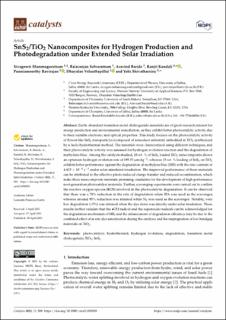| dc.contributor.author | Shanmugaratnam, Sivagowri | |
| dc.contributor.author | Selvaratnam, B | |
| dc.contributor.author | Baride, Aravind | |
| dc.contributor.author | Koodali, R | |
| dc.contributor.author | Ravirajan, Punniamoorthy | |
| dc.contributor.author | Velauthapillai, Dhayalan | |
| dc.contributor.author | Shivatharsiny, Yohi | |
| dc.date.accessioned | 2021-10-21T13:40:44Z | |
| dc.date.available | 2021-10-21T13:40:44Z | |
| dc.date.created | 2021-06-05T13:39:13Z | |
| dc.date.issued | 2021 | |
| dc.identifier.citation | Shanmugaratnam, S., Selvaratnam, B., Baride, A., Koodali, R., Ravirajan, P., Velauthapillai, D., & Shivatharsiny, Y. (2021). SnS2/TiO2 nanocomposites for hydrogen production and photodegradation under extended solar irradiation. Catalysts, 11(5). | en_US |
| dc.identifier.issn | 2073-4344 | |
| dc.identifier.uri | https://hdl.handle.net/11250/2824566 | |
| dc.description.abstract | Earth–abundant transition metal chalcogenide materials are of great research interest for energy production and environmental remediation, as they exhibit better photocatalytic activity due to their suitable electronic and optical properties. This study focuses on the photocatalytic activity of flower-like SnS2 nanoparticles (composed of nanosheet subunits) embedded in TiO2 synthesized by a facile hydrothermal method. The materials were characterized using different techniques, and their photocatalytic activity was assessed for hydrogen evolution reaction and the degradation of methylene blue. Among the catalysts studied, 10 wt. % of SnS2 loaded TiO2 nanocomposite shows an optimum hydrogen evolution rate of 195.55 µmolg−1, whereas 15 wt. % loading of SnS2 on TiO2 exhibits better performance against the degradation of methylene blue (MB) with the rate constant of 4.415 × 10−4 s−1 under solar simulated irradiation. The improved performance of these materials can be attributed to the effective photo-induced charge transfer and reduced recombination, which make these nanocomposite materials promising candidates for the development of high-performance next-generation photocatalyst materials. Further, scavenging experiments were carried out to confirm the reactive oxygen species (ROS) involved in the photocatalytic degradation. It can be observed that there was a 78% reduction in the rate of degradation when IPA was used as the scavenger, whereas around 95% reduction was attained while N2 was used as the scavenger. Notably, very low degradation (<5%) was attained when the dye alone was directly under solar irradiation. These results further validate that the •OH radical and the superoxide radicals can be acknowledged for the degradation mechanism of MB, and the enhancement of degradation efficiency may be due to the combined effect of in situ dye sensitization during the catalysis and the impregnation of low bandgap materials on TiO2 | en_US |
| dc.language.iso | eng | en_US |
| dc.publisher | MDPI | en_US |
| dc.rights | Navngivelse 4.0 Internasjonal | * |
| dc.rights.uri | http://creativecommons.org/licenses/by/4.0/deed.no | * |
| dc.subject | photocatalyst | en_US |
| dc.subject | hydrothermal | en_US |
| dc.subject | hydrogen evolution | en_US |
| dc.subject | degradation | en_US |
| dc.subject | transition metal chalcogenide | en_US |
| dc.subject | TiO2 | en_US |
| dc.subject | SnS2 | en_US |
| dc.title | SnS2/TiO2 Nanocomposites for Hydrogen Production and Photodegradation under Extended Solar Irradiation | en_US |
| dc.type | Peer reviewed | en_US |
| dc.type | Journal article | en_US |
| dc.description.version | publishedVersion | en_US |
| dc.rights.holder | © 2021 by the authors | en_US |
| dc.source.volume | 11 | en_US |
| dc.source.journal | Catalysts | en_US |
| dc.source.issue | 5 | en_US |
| dc.identifier.doi | 10.3390/catal11050589 | |
| dc.identifier.cristin | 1913885 | |
| cristin.ispublished | true | |
| cristin.fulltext | original | |
| cristin.qualitycode | 1 | |

